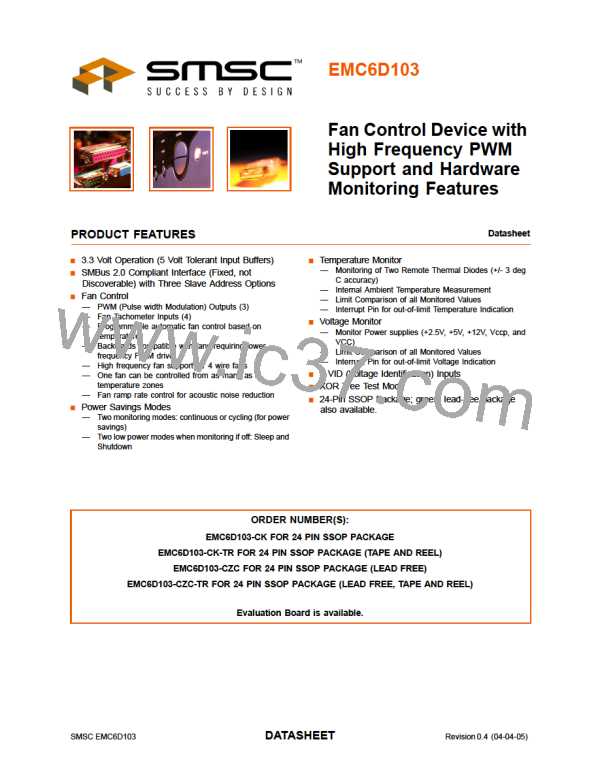Fan Control Device with High Frequency PWM Support and Hardware Monitoring Features
Datasheet
According to SMBus specification, v2.0 devices in a transfer can abort the transfer in progress and
release the bus when any single clock low interval exceeds 25ms (TTIMEOUT, MIN). Devices that have
detected this condition must reset their communication and be able to receive a new START condition
no later than 35ms (TTIMEOUT, MAX).
Note: Some simple devices do not contain a clock low drive circuit; this simple kind of device typically
may reset its communications port after a start or stop condition
5.7
Stretching the SCLK Signal
The EMC6D103 supports stretching of the SCLK by other devices on the SMBus. The Hardware
Monitor Block does not stretch the SCLK.
5.8
5.9
5.10
SMBus Timing
The SMBus Slave Interface complies with the SMBus AC Timing Specification. See the SMBus timing
diagram shown in the section titled Section 9.2, "SMBus Interface," on page 84.
Bus Reset Sequence
The SMBus Slave Interface will reset and return to the idle state upon a START field followed
immediately by a STOP field.
SMBus Alert Response Address
The EMC6D103 device responds to the SMBus Alert Response Address, 0001 100, if the INTEN bit
(register 7Ch bit 2) is set and one or more status events bits are high. The interrupt signal (INT#),
which can be enabled on either the PWM2 or TACH3 pins, can be used as the SMBALERT#. See the
section describing the Interrupt Status Registers on page 26 and the section describing the Interrupt
Pin on page 28 for more details on interrupts.
The device can signal the host that it wants to talk by pulling the SMBALERT# low, if a status bit is
set in one of the interrupt status registers and properly enabled onto the INT# pin. The host processes
the interrupt and simultaneously accesses all SMBALERT# devices through a modified Receive Byte
operation with the Alert Response Address (ARA).
The EMC6D103 device, which pulled SMBALERT# low, will acknowledge the Alert Response Address
and respond with its device address. The 7-bit device address provided by the EMC6D103 device is
placed in the 7 most significant bits of the byte. The eighth bit can be a zero or one.
Table 5.4 Modified SMBus Receive Byte Protocol Response to ARA
ALERT
RESPONSE
ADDRESS
EMC6D103 SLAVE
ADDRESS
FIELD:
Bits:
START
RD
ACK
NACK
STOP
1
7
1
1
8
1
1
After acknowledging the slave address, the EMC6D103 device will disengage the SMBALERT# pull-
down by clearing the INT enable bit. If the condition that caused the interrupt remains, the Fan Control
device will reassert the SMBALERT# on the next monitoring cycle, provided the INT enable bit has
been set back to ‘1’ by software.
Note: The INT# signal is an alternate function on the PWM2 and TACH3 pins. The EMC6D103 device
will respond to the SMBus Alert Response address even if the INT# signal is not selected as
the alternate function on one of these pins as long as the following conditions exist: the INTEN
SMSC EMC6D103
Revision 0.4 (04-04-05)
DATA2S1HEET

 SMSC [ SMSC CORPORATION ]
SMSC [ SMSC CORPORATION ]